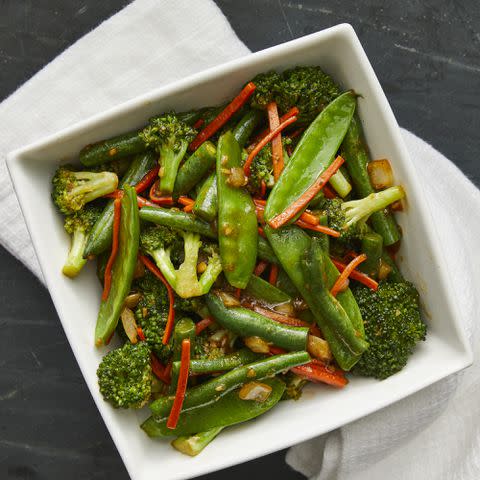3 Simple Methods for Freezing Fresh Ginger so It Lasts for Months
Freeze fresh (and potent) ginger for the long haul.

Few things are as recognizable in flavor and aroma as ginger. It has such a uniquely spicy and juicy quality that adds a burst of fire to whatever it touches.
Being labeled a root, it might seem like ginger has a significant shelf life (and comparatively, it does – up to 2 to 3 weeks at room temperature or in the fridge), but as anyone who does the shopping or prepares the meals knows, that time goes by in a blink of an eye.
Those few weeks are a blip in time for any product placed in the fridge and promptly forgotten about. But the freezer extends the life and trademark of your ginger so you can enjoy longterm.
Related: What Is Ginger and How Do I Use It?
How to Select and Prepare Ginger for Freezing
Freezing ginger is incredibly simple. You don't need any special training or to hastily click any "add to cart" buttons – if you have a reliable knife, perhaps some plastic wrap, a freezer-friendly zip-top bag or sealable container, and a marker, you're golden. (If you'd prefer the ginger to be prepped further, you may need a food processor or blender.)
The ginger that freezes the best is still fresh — not already traveling down the path of dull, wrinkled, dry, cranky, etc). Fresh ginger is firm, plump, smooth (between the knobs, of course), and fragrantly pungent. This ginger has the best flavor, which will ensure it holds up through freezing.

Get the recipe: Big Soft Ginger Cookies
Step-by-step Instructions for Freezing Ginger
Essentially, there are three ways you can go about freezing ginger. Preserve pureed, cut, or whole ginger depending on your recipe needs and time constraints.
Pureed Ginger
Add ginger, peeled or unpeeled to a food processor or professional-grade blender (if unpeeled, you may need to blend it longer). Spoon the resulting paste into an ice cube tray and freeze. Once frozen, transfer he paste cubes to a zip-top bag to keep them from collecting freezer burn. Label and date the bag.
If you'd like your puree a bit looser, add water a little at a time until you reach the desired consistency. Pour the puree into the ice cube tray and proceed as you would with the paste.
Related: Try This Unexpected Way to Store Fresh Ginger in the Fridge
You can also measure the puree into zip-top bags, lay them down, push out as much air as possible without smushing out the puree, seal, label, and freeze them flat on sheet pans lined in parchment paper or paper towels.
Cut Ginger
Peel and cut the ginger into the portions most often used by you in your kitchen. For example, if the recipes you buy ginger for typically call for grating a 1-inch section of ginger, peel the whole knob, and cut it into 1-inch sections.
Place the pieces in a zip-top bag or container, remove as much air as possible if using a bag, seal, and label. Labeling allows you to recognize what is in the bag or container, clueing you in months from now when you've forgotten you were ever this resourceful.
If minced is your thing, get to chopping. While it takes a bit longer, it'll save you valuable prep time later. Add the minced ginger to a zip-top bag, lay it flat, and press the ginger into a flat layer, before sealing and labeling.
Related: Can Ginger Ale Actually Help an Upset Stomach?
Whole Ginger
Choosing to peel or not to peel your ginger before freezing it whole is entirely up to you. There isn't a discernable difference between eating ginger with the skin or without, but if you're concerned about the texture, or planning on peeling it before using it regardless, go ahead and do it beforehand.
Wrap the whole thing tightly in plastic wrap, place it in a zip-top bag or container, seal it, and label.
Best Storage Practices for Frozen Ginger
Try and use that frozen ginger within 6 months. It won't exactly hurt you after that, but it'll sure be less flavorful.
Be sure to use freezer-specific bags or containers. They'll do the good work of keeping your ginger as fresh-tasting as possible, sealing in goodness and keeping out odors.
Potential Uses for Frozen Ginger
Frozen ginger that's going to be grated can be peeled and grated straight from the freezer – there's no need to thaw it. Plus, if you don't use all that you took out, simply return it to the freezer.
Professional tip: use a spoon to peel it. A spoon is a great trick when it's fresh, but an even better friend when working with frozen ginger. Using a peeler or a knife to do the task is possible with the fresh stuff, but it will be tricky and, honestly, awful once frozen. Grated frozen ginger is especially great in sauces and cocktails.

Get the recipe: Ginger Veggie Stir-Fry
If the recipe calls for slices of ginger, you'll need to thaw it first. Remember, while grating frozen ginger is easy (perhaps even more so than fresh) cutting it with a knife is much more difficult and, in fact, quite dangerous. Microwave the ginger for about 15 seconds before you attempt to cut it.
If you cut your ginger into slices before freezing, defrost the slices before using them in the dish. For frozen minced ginger, break off what you need, thaw them in the microwave, and toss them in your dish.
Frozen puree cubes are perfect in a soup, braise, or stir-fry; just toss the cube right in. If baking with the puree, let it come to room temperature first.
Related:
Read the original article on All Recipes.

